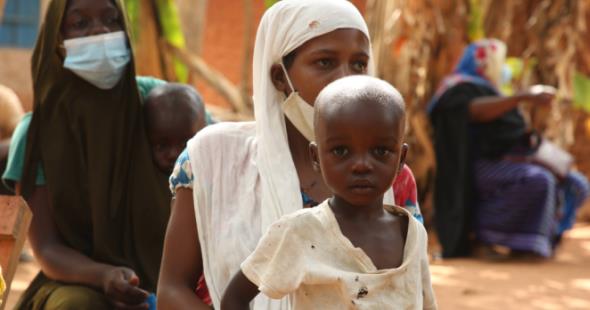At-risk populations

GOAL: Minimize TB and hepatitis deaths from missed diagnosis
Finding the missing millions of people with TB or hepatitis who are not diagnosed or reported to health systems has remained an elusive goal, despite the existence of tests and effective treatments for both diseases. Our TB and hepatitis strategy focuses on approaches to reduce the diagnostic gap through the development of new tests, especially those that can be used closer to the point of care, and innovation in delivery models. Diagnosis of both diseases requires a decentralized approach to testing programmes, with more tests suitable for community and self-testing, supported by digital tools that can ensure linkage to care. Easy-to-use, high-quality tests must be accompanied by innovation in the delivery of testing programmes and a switch to active case-finding, particularly to reach at-risk populations who are disproportionately affected.
Tuberculosis
In 2019, 10 million people fell ill with TB and 1.5 million people died from the disease. One in 10 people with TB were believed to be co-infected with HIV, and close to half a million people developed drug-resistant TB. More people received life-saving treatment than ever before, largely due to improved detection and diagnosis, but a staggering 2.9 million people remain undiagnosed or unnotified every year. Most TB cases are found among the urban poor, and improving access to diagnosis remains a key priority to meet the WHO End TB strategy of 90% reduction in the annual TB deaths by 2030. COVID-19 has negatively impacted services in most high-burden countries, and is threatening to reverse global progress against TB. TB case notifications declined by a third in 2020,7 and it is projected that there will be an additional 4.7 million cases of TB between 2021 and 2025 due to disruptions related to the pandemic.
Our focus is on strengthening community-based testing and enabling integrated testing strategies for respiratory symptoms to find the millions of missed cases.
Workstreams:
- Expand portfolio of sampling methods (including non-sputum-based), platforms and digital tools for TB and integrated testing, including bi-directional testing for TB and COVID-19
- Generate evidence for policy to enable active case-finding for TB by bringing testing closer to patients through community and self-testing
- Support new delivery models to increase access to testing, in particular for drug-resistant TB, and strengthen sequencing capabilities for surveillance
Indicative deliverables:
- An expanded portfolio of open-access resources for developers of TB diagnostics and implementing countries, including an expanded validation platform for ongoing computer-aided detection (CAD) development and implementation planning
- Evidence dossiers to support policy evaluation of 5 new TB tests
- 5 new CE-marked tools for detection of TB and integrated testing strategies, including at least 1 digital diagnostic solution
- Expanded use of molecular testing for TB through the uptake of new sampling strategies, notably through private sector channels
- Market interventions for 3 new TB and associated tests to increase affordability
- 10 demonstration studies on community, self-sampling and bi-directional screening approaches
- Technical guidance and best practice materials to support countries and partners in prioritizing decisions
Hepatitis
Globally, there are estimated to be 3 million new infections and 1.1 million deaths from viral hepatitis each year.
Despite a ground-breaking cure for hepatitis C virus (HCV) completing development in 2014, there has been limited progress towards reaching the WHO goal of hepatitis elimination by 2030. Latest data from the 2021 WHO Global progress report on HIV, viral hepatitis and sexually transmitted infections indicate that over 230,000 people die annually due HCV, and 58 million people globally are living with HCV. Almost 80% of people living with HCV are in LMICs, and of those, 21% are estimated to have been diagnosed. While the HCV cure is already widely available in LMICs, usually at affordable prices, the challenge again remains finding the missing millions, as fewer than one in four of those living with HCV have been diagnosed. There is a great lack of simplified, decentralized diagnostics that can be integrated into existing healthcare models, and few countries are willing to embark on HCV elimination as “pathfinders” for others. Over 50 million people living with HCV will need to be diagnosed and linked to treatment in the next 10 years to reach the elimination targets. Elimination depends on continued development of simplified point-of-care diagnostics, alongside partnership with countries to catalyse and prioritize HCV.
Our focus is on increasing access to HCV testing, and enabling test-and-treat strategies. We are also exploring the potential to replicate this approach for hepatitis B virus and are actively seeking funding to support this.
Workstreams:
- Expand active case-finding through the creation of targeted community screening packages, using multiplex tests and deployment of fit-for-purpose self-testing strategies
- Support decentralized, simplified, integrated services through true point-of-care confirmatory testing and liver staging, to allow same day test-and-treat
Indicative deliverables:
- Toolkits to facilitate the introduction of cost-effective national screening programmes
- A true point-of-care core antigen (cAg) RDT
- Evidence on combination RDTs
- WHO-approved HCV self-tests available for use, including a supporting digital patient-centred toolkit
- Testing packages for best use and scale up of self-testing
Quick links
- WHO consolidated guidelines on tuberculosis Module 3: Diagnosis - Rapid diagnostics for tuberculosis detection (2020)
- TAG: Tuberculosis diagnostics – Pipeline Report 2020
- WHO Global Tuberculosis Report 2019
- Stop TB Partnership Global Plan to End TB 2018–2022
- WHO tuberculosis resources
- Stop TB Partnership New Diagnostics Working Group
- WHO Global health sector strategy on viral hepatitis 2016-2021

